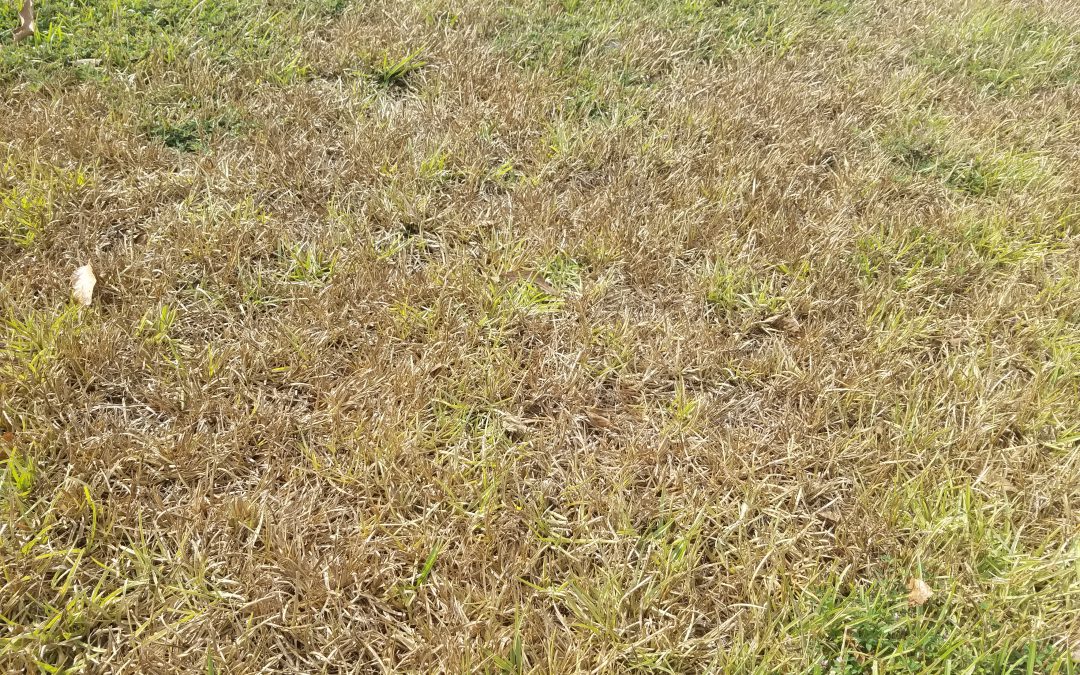
by Daniel J. Leonard | Sep 11, 2025
Many turfgrass yards, including mine, are feeling the effects of an extended droughty period this month. While one of the benefits of the primary turf species grown in the area (Centipedegrass, Zoysiagrass, Bermudagrass, and Bahiagrass), is their drought tolerant nature, they aren’t impervious to drought. Even with these tough grass species the difference between a yard coming out of a drought in decent shape versus dead is as simple as remembering the answers to the following four maintenance questions.
How much should I water to keep my grass alive?
Lawngrass needs about ¾-1” of water per week to remain looking its best and growing vigorously. Obviously, unless you have an irrigation system, keeping a large yard of turfgrass in that ideal water range is going to be hard or impossible. So, what to do? I encourage homeowners to focus their efforts on keeping grass around highly visible and often used areas of the yard well-watered, letting outlying areas fend for themselves until rain resumes. To ensure you’re putting out the optimal ¾-1” of irrigation per watering event, spread a few straight sided cans (tuna or cat food cans work great) under the sprinkler’s range, allow it to run until you reach the 1” mark, and note how long it took to apply that amount of water. This will help you dial in your watering and ensure water isn’t wasted.
Should I mow during a drought?
We all know that an unmown yard looks unkempt. However, given that mowing is a major stress on turfgrass, mowing during a drought can weaken your yard’s ability to recover when the drought ends. If you must mow to keep things looking neat, try to mow only areas that you keep watered and raise your mower’s deck to reduce the amount of leaf tissue you cut from the grass. Mowing in this manner will reduce stress on your turf and keep the yard from appearing weedy and unkempt. My unirrigated Centipedegrass yard has been flowering and setting seed over the last few weeks. My last mowing event (during the current dry period) was designed to only remove seedheads and minimize removal of leaf tissue.

Unirrigated Centipedegrass turf showing drought stress – photo courtesy of Daniel Leonard.
Should I fertilize?
This one is easy! Don’t fertilize grass during a drought! For one, fertilizer promotes growth, and grass isn’t trying to grow during a drought, simply survive. Fertilizing in these times is another unnecessary stress. Additionally, fertilizer requires water to transport nutrients down to the plant roots. If there is no water to do so, it will simply sit there and wait on rain. Also, some or all the nitrogen in the fertilizer applied will volatize and return to the atmosphere, wasting your time, money, and effort and stressing your turfgrass in the process. Hold the fertilizer until rain begins again.
What do I do about weeds?
Turfgrass isn’t the only thing stressed during droughts; weeds are as well. During stressful events like droughts, all plants (weeds included) stop growing and enter survival mode. This has major implications for weed control, as herbicides are not particularly effective on weeds with drought defenses up. In addition to being ineffective, herbicides can injure stressed turfgrass, preventing a healthy recovery post-drought. So, keep the herbicide off the yard until the weeds, and your turf, are happy and growing again.
Maintaining an unirrigated lawn during drought is more about what you don’t do – less mowing and no fertilizer or herbicide applications – than what you do. Mowing too low, applying fertilizer, and trying to control weeds with herbicide are all potential stressors of turf and can inhibit its recovery when the rain returns. The best you can do to keep your lawn healthy in dry times is to apply ¾-1” of water per week and pray for rain! For more information about lawn management or any other horticultural topic, contact your local UF/IFAS County Extension office.

by Lauren Goldsby | Dec 13, 2024
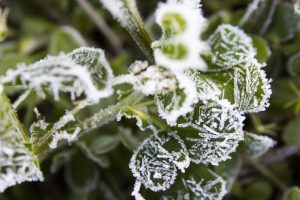
UF/IFAS Photo by Tyler Jones
Many of us experienced our first freezing temperatures in the Panhandle last week. As we welcome winter, here are some helpful resources to prepare your plants when temperatures dip in the months ahead:
Frost in the Panhandle? Practical Tips for Protecting Your Garden
Cold Protection of Landscape Plants EDIS
One tip you’ll often see in these recommendations is to water your plants before a freeze. At first, this might seem counterintuitive, but wet soil can actually help your plants weather freezing temperatures for several reasons.

Soil naturally has small pockets of air. UF/IFAS Photography: Tyler Jones.
Water’s ability to absorb and hold heat—known as high specific heat—makes it a powerful tool against cold stress. Dry soil contains air spaces that don’t hold heat well. By watering your soil, you replace those air pockets with water, which absorbs more heat during the day and releases it slowly at night. This helps keep the soil and roots warmer than the surrounding air. Covering plants with sheets and frost cloth can help trap this warmth around the plants.

Dehydration from freeze damage can make leaf tissue look similar to drought stress. UF/IFAS Photo by Cat Wofford
Beyond heat retention, water also reduces the effects of cold stress. Both freezing and drought conditions cause plant cells to lose water, leading to dehydration. Water is essential for many plant functions including photosynthesis, nutrient transport, and maintaining structural support of the plant. Good water availability within the plant before the freeze helps reduce the water stress associated with cold damage. However, watering right after a freeze will not provide the same benefits because root activity slows in the cold weather.
For best results, water the soil in the morning before a freeze, focusing on the soil, rather than the leaves, as wet leaves are more prone to freeze damage. During fall and winter, plants generally require less frequent watering, so check the soil moisture before watering to avoid overwatering. Standing water can harm roots and increase stress on the plant.

Get familiar with your soil by checking moisture level before you water. UF/IFAS Photo by Tyler Jones

by Larry Williams | Oct 31, 2024
So far, our fall has been unusually dry with warmer temperatures. Even though our average annual rainfall is around sixty-two inches per year, we don’t always receive rain exactly when we need it. There are times when we need to apply additional water. During dry weather, employ the following water management practices to improve the water efficiency of your lawn and landscape.
Mulching helps conserve water. On bare ground, about sixty percent of the water can be lost through evaporation. A two to three-inch layer of mulch will help hold onto the water so the plants can use it. Try to mulch the entire root zone when possible or at least apply mulch all the way around the plants out to the end of the branches.
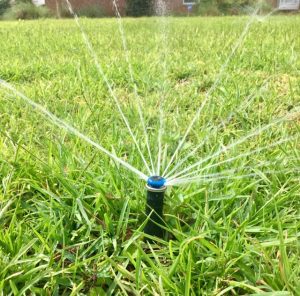
Irrigate on as needed basis during dry periods. Credit: Larry Williams
When watering, a thorough soaking to wet the soil to a depth of six to eight inches is much better for plants than light, frequent watering. Three to five gallons of water applied to one spot under the canopy of trees or shrubs should thoroughly saturate the root zone in that location. During dry periods, as a general rule), twenty-five percent of the root system, when watered thoroughly, can absorb all the water a plant requires at any given time.
When watering lawns, apply one inch of water per week when we are not getting rain. Although many sprinklers have irrigation rates of ¼ inch per hour, some may apply up to one inch per hour. Measure your irrigation rate and uniformity by placing several open-top containers of the same size under the sprinkler and see how long it takes to apply a known amount of water such as ½ inch.
An efficient irrigation program on turf should not begin until the lawn grass shows signs of moisture stress. Symptoms include a dull and bluish-green color and leaf blades folding. The most efficient time to irrigate is between sunset and sunrise because of less evaporation, less wind and lower temperatures. Early morning is the next most effective time to irrigate while midday is the least efficient.
Avoid fertilizing drought-stressed plants. Fertilizers are chemical salts and will dehydrate roots when water is in short supply. If you need to apply a pesticide, make certain the plant is not wilted at the time and spray during early morning or late afternoon. You should also avoid unnecessary pruning of plants during drought. Pruning encourages new growth, which has a high demand for water.
For more information on watering efficiently and drought tolerant plants, contact the UF/IFAS Extension Office in your county or visit the following website: http://gardeningsolutions.ifas.ufl.edu/care/irrigation.

by Beth Bolles | Jun 20, 2024
The May Gardening in the Panhandle Live focused on the various aspects of turfgrass care and species characteristics.
The panel included:
Dr. Bryan Unruh, UF IFAS Extension Turfgrass Science Professor
Sheila Dunning, UF IFAS Extension Commercial Horticulture Agent in Okaloosa County
Josh Criss, UF IFAS Extension Residential Horticulture Agent in Santa Rosa County
Daniel Leonard, UF IFAS Extension Horticulture Agent and Director in Calhoun County
Q: Does No Mow March cause more problems in maintaining a good lawn?
Pay attention to what you are leaving behind. If you have aggressive perennial weeds, that could cause issues later. Also, be aware of what types of weeds. Annual wildflowers may be acceptable that will reseed next year. Mowing before seeds mature is always an option too.
Remember that if there are significant weeds, they are taking advantage of a void in the turf. Find out why the turf is not growing as well and work on that issue. Improve the health of the grass to have less issues with some weeds.
References: https://apnews.com/article/gardening-no-mow-may-lawns-6aa1669b9e9bb5b5d8ea671c44d186f2
Q: What is an unhealthy lawn?
Grass that is not performing at a level that is normal for that turf. Not growing well, does not have appropriate color for the species, thinning out. The difficult part is figuring out why. Could be that that turf is not suited to the site, cultural practices are an issue, pest problem.
We tend to manage turf too much. Take a more minimalistic approach and as needed for turf management instead of a scheduled maintenance plan.
Q: Fertilizer and pesticide inputs aside, can ornamental lawns provide environmental benefits such as carbon sequestration?
Plants remove CO2 and supply O2. Turf areas can reduce temperatures, serve as erosion management and build soil. Also filtering some pollutants. Turfgrass also has huge potential to accumulate and store carbon. Turf has many recreational uses that other surfaces don’t offer and the overall aesthetics of a healthy lawn can improve value of the property.
References: Turf Management to Protect the Environment, https://www.youtube.com/watch?v=w2ajI-t4EoY
Q: What is the best grass for Florida?
You have to match the turf to an appropriate site and turfgrass may not be the best choice for a site. On an urban site, shade from trees will also dictate if turf is appropriate. The best grass for the back yard may not be the best suited for the front yard.
Centipedegrass is a good selection for the case of a grass that grows well with low inputs. It will be a lighter shade of green which is its natural color.
If you prefer to have inputs of fertilizer and water routinely, centipedegrass would not be the best choice. Zoysiagrass is more suited for those who desire a more magazine cover type lawn that is well manicured.
A field type lawn is best with bahiagrass.
Q: Is zoysiagrass the fastest growing market for turfgrass?
There are now good zoysiagrass varieties on the market and better ones coming along.
Zoysiagrass is a very drought tolerant species but it survives by going into dormancy. It survives without water by going from green to bluishgray to brown very quickly. In order to maintain a green, well manicured zoysiagrass lawn, irrigation input is needed.
Q: Can I grow a lawn from centipedegrass seed? How long will it take to fill in?
It takes 3 years to establish a lawn from centipedgrass seeding. That is with minimal inputs but mowing is important in the establishment process.
Dr. Unruh does not recommend seeding into patches because water needs for seed are higher than established grass. Sodding or plugging is better for patching spots.
Q: What is the best choice of grass for a partly shaded lawn/best under a large tree?
Long term, you need a shade tolerant grass such as one of the St. Augustinegrasses or certain cultivars of zoysia (Palisades is one). As the tree grows over the years, grass may not remain suited for that location.
Q: What type of grass would you recommend for a meadow area that would be natural/unmowed?
Bahiagrass is a good option.
Q: How do we encourage bee lawns?
Centipedegrass flowers will attract some bees. Clovers (Red, white, hopclover) in the winter months through spring. Consider your space. May just be small sections or at the edge of the yard.
Q: How often should you aerate your lawn and what is the best method?
Sandy soils can compact. Every other year aeration if you have traffic patterns from vehicles, play, or paths. Use a ½ tine with lots of holes back and forth over the lawn.
Q: How to maintain a healthy lawn in our hot and humid summers?
Overwatering is common. Grass gives signs of needing water such as leaf blades folding in half, a color change, and grass not recovering after walking. Calibrate your system to apply ½ to ¾ inch at each time.
References: Mowing Your Florida Lawn, https://edis.ifas.ufl.edu/publication/LH028
Q: How to measure water volume with an automatic irrigation system.
In a zone, randomly place 10-15 straight edged cans that are all the same size. Run your system for a set time and see how much is in each can. You will be able to see where coverage is poor, just right, and overlapping too much. Measure with a ruler and average out the amount. Adjust your time to meet ½ to ¾ inch.
Each zone is calibrated separately.
Same for zoysiagrass but this grass will show you where your system is not functioning well since it’s response to drought is to go dormant. Still ½ to ¾ inch as needed.
References: Watering Your Florida Lawn, https://edis.ifas.ufl.edu/publication/LH025
Calibrating Your Sprinkler System, https://gardeningsolutions.ifas.ufl.edu/care/irrigation/calibrating-your-irrigation-system/
Q: Do I have to fertilize and apply pesticides to have a healthy lawn?
No. All plants need nutrition and fertilizer is just one source of nutrition. A good soil can provide sufficient levels of nutrients for the lawn. Sandy soils may need supplemental nutrients. Could be from compost incorporated in as well.
References: The Florida Fertilizer Label, https://edis.ifas.ufl.edu/publication/SS170
Q: My yard is a mix of grasses. Is this a problem for fertilizer and watering?
You may need to fertilize differently depending on the needs of the various grasses. If a grass is growing into another, then it is favorable conditions for that grass – sunlight, mowing, water availability. You may have to manage for the one that is doing the best.
Q: Should I bag my mowing clippings for my Zoysia lawn or not?
Generally the recommendation is to allow clipping to fall for a yard that is being routinely mowed. Blades will compost. The exception is with zoysia when thatch is becoming a problem or when you have neglected mowing for a period and clumps of clipping are piled on the lawn.
References: Zoysiagrass for Lawns, https://edis.ifas.ufl.edu/publication/LH011
Q: Is weed control beneficial or harmful?
Improperly used herbicides could have environmental impacts. Follow the label carefully. Manage weeds through cultural practices too.
Q: How do I get rid of crabgrass?
Annual weed that germinates when soil temps reach 55 degrees F. Could be mid-January or a little later. Pre-emergent herbicides can help. Not many options for post emergent weed control.
From Dr. Unruh: We do not recommend Weed and Feed products since timing is different for both. North Florida fertilizer applications should not occur before mid-April.
0-0-7 with pre-emergent would be the only exception. The 0-0-7 is just potassium.
Q: How to detect, kill and prevent ground pearls.
There are no chemicals controls for ground pearls. Thinning out areas. Insects that are in the soil, with pearl stage attached to the roots. Females are hot pink and crawlers.
Maybe something in the future. Try to outgrow ground pearls with faster growing grasses such as St. Augustinegrass and zoysiagrass.
Q: How do you control a heavy infestation of doveweed?
Do not handpull. Annual weed that germinates later when soils reach 70 degrees F. Pre-emergent herbicides. Mow more often and manage irrigation. Improve drainage. Clean mowers too.
Q: Are there herbicides that will not harm birds?
Insecticides have the biggest impact on wildlife compared to other types of pesticides. Many herbicides use a carrier that looks like a grain so water immediately according to label to move chemical off carrier. Follow the restrictions about application close to water. Read the label.
Q: Are all zoysia grasses hard to keep out of landscape beds?
Establish a border with edging to block the growth. Must be buried and above grade as well.
Q: If we’ve lost most of our backyard due to killing off weeds with only some grass left, how’s the best way to start?
For smaller spots, allow surrounding turf to run back into areas. Resodding areas or plugging new grass.
Q: Large sections of my front lawn died last summer and I diagnosed it as brown spot/large patch. How do I address?
Why having large patch – poor drainage and fix that issue. Also zoysiagrass is susceptible to large patch. You can restablish grass but manage so conditions are not as suitable for the disease. Water as needed and nutrients only as needed.
Q: We have a lot of bald spots in our yard that we can’t seem to get rid of.
Diagnosing is necessary – compaction, water issues, fertility problems. Loosen area and make sure water is able to move into soil. Then can reestablish grass.
Q: If your centipede lawn is spotty with a variety of weeds, would it be better to kill the whole thing off and sod with Zoysia?
Centidegrass and zoysia have different pH requirements so may not be as simple as just replacing with new type of grass. Why is centipedegrass not doing well? Soil testing and cultural practice evaluation before considering to replace grass. Current centipedegrass may just need different care to thrive.
Q: What is the best alternative to turf grass?
Perennial peanut is an option as a vegetative cover. It does freeze back in many spots of North Florida. It does creep and there are many cultivars. Edging is necessary.
Sunshine mimosa is an option but it also freezes back. Lyre leaved sage for shady areas.
Silkgrass for drier areas.
Frogfruit for moist areas
Final thoughts from Dr. Unruh
Shut the irrigation off. Most people tend to overwater. Back off inputs to as needed instead of a schedule. A few weeds are ok for most home lawns and lawns can still be attractive.

by Evan Anderson | Mar 29, 2024
After a relatively cold winter like the Florida panhandle has experienced the last couple of years, it’s always gratifying to see plants greening up in the spring. Anyone who enjoys the outdoors is likely to want to get out there and start helping things grow. That means it’s time to get the irrigation system up and running every day, right?
Probably not!
The conditions in our region can be harsh on plants. The soils are very sandy, meaning they don’t easily hold on to water or nutrients for plants to use. The weather ranges from freezing cold in the winter to sizzling hot in the summer. Rain might come down in 20-inch bursts or not at all for weeks at a time.
With all these challenges plants face, it’s very important to choose ones that can handle all that our environment throws at them. Native plants and those designated as “Florida Friendly” tend to be well suited for our location, but they still may need some care. They must be placed in the correct location in the landscape based on their needs for sunlight, water, and other factors. If you choose the right plant and place it in the right location, you’ll drastically reduce the amount of management that it needs on an ongoing basis. This includes watering.
While actively growing, plants – whether that means towering trees or low-growing grass – take up water through their roots and give some off in the form of water vapor through their leaves. If the amount of water in the soil is more than the plant is giving off, it doesn’t need more! Watering at these times can actually harm, rather than help. The roots of overwatered plants typically start to die back, which can lead to symptoms such as patchy dieback of foliage or what may look like nutrient deficiency. Overwatered areas might also see an uptick in water-loving weeds such as dollarweed, which will be difficult to control unless the area is dried out a bit.
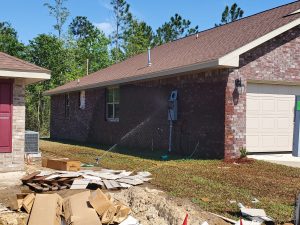
Set irrigation systems to water early in the morning rather than at midday, and make sure they water plants, not walls.
It is tempting to think that our sandy soils drain quickly enough to make watering a constant necessity, but remember! We’ve already chosen plants that survive well in our location. Even our turfgrasses are chosen for their ability to withstand drought. There may only be three or four months out of a year that become dry enough to warrant extra irrigation at all, and even then, it’s probably less than most people expect!
For lawns, a general rule is to water only when the grass is showing signs of drought stress. Leaf blades may fold up lengthwise, the lawn’s color may become duller, and footprints in the turf persist rather than springing back. If the turf needs watering, apply ½ to ¾ inch of water per irrigation – that’s all!

Improperly calibrated irrigation systems can do more harm than good.
To figure out how much that is, set several small, empty straight-edged cans such as cat food tins or tuna cans out in the lawn. Run the irrigation for a set period of time to see how much water collects. This will also highlight any inconsistencies in watering, so you can try to adjust your irrigation system to water evenly by replacing broken nozzles and making sure the whole area is covered with no gaps or overlaps. Make sure the irrigation system is equipped with a rainfall shutoff device as well, to automatically stop watering when it rains (which it often does regularly).
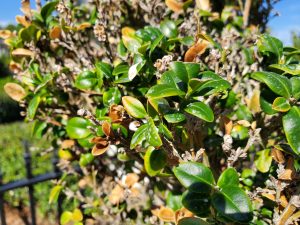
Overwatered shrubs may display patchy dieback or yellowing leaves.
For landscape plants such as trees and shrubs, you may not need any supplemental irrigation at all unless there is a severe drought. Know your plants’ needs and keep an eye on the weather. Droughts, if we do have them, usually occur in the spring or fall in our area. During the summer, daily rainstorms often allow us to keep our irrigation systems off for months at a time!
Water appropriately and you may notice a reduction in your water bill, fewer plants that need to be replaced, and fewer water-loving weeds. You’ll also help the environment by reducing runoff into water bodies.
For more information on watering, contact your local Extension office. There is also a wealth of information to be found online, with resources such as the Florida Friendly Landscaping program and UF’s EDIS publications (see “Watering Your Florida Lawn”, for example). Happy watering!














